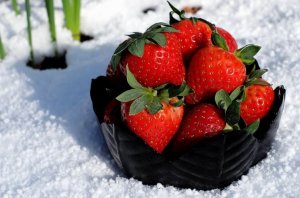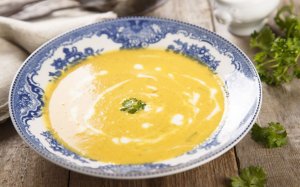What to Eat During Your Winter Workout Routine?

The athlete’s diet should adapt to the different seasons. When winter arrives with its cold temperatures, you crave warmer meals, therefore you need to adjust your diet. If you want to know which meals are better during this cold time of the year, keep reading! We’ll tell you what to eat during your winter training routine.
The key is to eat healthily, making balanced, nutritious and warm meals. This way your body will be well prepared for any physical activity and will recover more efficiently. Keep reading as we explain the key to a healthy diet for the winter months.
Seasonal fruits to eat during winter
We have already mentioned the importance of eating seasonal food. Not only because they are cheaper, but also because of the benefits that eating fresh fruits and vegetables bring.

Seasonal fruits are at their optimal condition. They have the best taste and the highest amount of nutrients. Also, if you care about your environment, these fruits are much more sustainable too.
Fruits for each season:
- Summer: melon, watermelon, figs or pears.
- Autumn: grapes, persimmon, pomegranate or apples.
- Winter: oranges, tangerines or grapefruit.
- Spring: strawberries, plums or peaches.
Now that you know each season’s fruits, you can benefit from their properties. Remember that increasing the intake of fruits is highly beneficial for athletes and their performance.
Warm vegetables
If there’s a dish synonymous with healthy eating, that would be a salad. But during the winter, this versatile dish seems too cold, and therefore unappetizing. One way to continue enjoying our veggies throughout the winter months is to cook them and eat them warm.

Making warm veggies doesn’t mean that you will have to spend a long time in the kitchen cooking them. Next, we’ll show you different ways of preparing your veggies and keeping yourself warm, before and after your workout.
- Green beans and cooked potatoes. A traditional, fast, healthy and nutrient-rich recipe. You only need to boil both vegetables separately and then season them with a little of salt and olive oil.
- Oven cooked vegetables. Peel and chop any vegetables you choose. You can use one vegetable or combine many. Add a pinch of salt and a little olive oil and cook in the oven until they are ready. It’s easy! Now you have a vegetable dish that perfectly accompanies meat or fish.
Cooking in the oven, boiling or steaming are the best and healthiest ways of cooking your vegetables. Unlike fried vegetables, you won’t add extra fat and you maintain all of the nutritional benefits. Besides, there are so many different veggies to choose from, that it’s impossible to become bored.
Soup
If there’s a typical winter dish it’s soup. For athletes this is an interesting meal. Soup is perfect to rehydrate after working out. When you finish an exercise session, you are likely to be dehydrated and in need of water. Immediately after all physical activity, soup is perfect because it provides you with, not only liquids but also nutrients.
A bowl of low-sodium vegetable soup with a grilled steak would be an ideal meal or dinner to enjoy after your winter workout session. The meat will provide the proteins, and the soup will rehydrate the body.
During the winter months, athletes must make changes and adapt their diet to the colder temperatures. It doesn’t mean you have to spend more time in the kitchen, it just means you need to prepare your meals differently. Remember to buy seasonal products, enjoy soup to hydrate your body and consume warm vegetables.
The athlete’s diet should adapt to the different seasons. When winter arrives with its cold temperatures, you crave warmer meals, therefore you need to adjust your diet. If you want to know which meals are better during this cold time of the year, keep reading! We’ll tell you what to eat during your winter training routine.
The key is to eat healthily, making balanced, nutritious and warm meals. This way your body will be well prepared for any physical activity and will recover more efficiently. Keep reading as we explain the key to a healthy diet for the winter months.
Seasonal fruits to eat during winter
We have already mentioned the importance of eating seasonal food. Not only because they are cheaper, but also because of the benefits that eating fresh fruits and vegetables bring.

Seasonal fruits are at their optimal condition. They have the best taste and the highest amount of nutrients. Also, if you care about your environment, these fruits are much more sustainable too.
Fruits for each season:
- Summer: melon, watermelon, figs or pears.
- Autumn: grapes, persimmon, pomegranate or apples.
- Winter: oranges, tangerines or grapefruit.
- Spring: strawberries, plums or peaches.
Now that you know each season’s fruits, you can benefit from their properties. Remember that increasing the intake of fruits is highly beneficial for athletes and their performance.
Warm vegetables
If there’s a dish synonymous with healthy eating, that would be a salad. But during the winter, this versatile dish seems too cold, and therefore unappetizing. One way to continue enjoying our veggies throughout the winter months is to cook them and eat them warm.

Making warm veggies doesn’t mean that you will have to spend a long time in the kitchen cooking them. Next, we’ll show you different ways of preparing your veggies and keeping yourself warm, before and after your workout.
- Green beans and cooked potatoes. A traditional, fast, healthy and nutrient-rich recipe. You only need to boil both vegetables separately and then season them with a little of salt and olive oil.
- Oven cooked vegetables. Peel and chop any vegetables you choose. You can use one vegetable or combine many. Add a pinch of salt and a little olive oil and cook in the oven until they are ready. It’s easy! Now you have a vegetable dish that perfectly accompanies meat or fish.
Cooking in the oven, boiling or steaming are the best and healthiest ways of cooking your vegetables. Unlike fried vegetables, you won’t add extra fat and you maintain all of the nutritional benefits. Besides, there are so many different veggies to choose from, that it’s impossible to become bored.
Soup
If there’s a typical winter dish it’s soup. For athletes this is an interesting meal. Soup is perfect to rehydrate after working out. When you finish an exercise session, you are likely to be dehydrated and in need of water. Immediately after all physical activity, soup is perfect because it provides you with, not only liquids but also nutrients.
A bowl of low-sodium vegetable soup with a grilled steak would be an ideal meal or dinner to enjoy after your winter workout session. The meat will provide the proteins, and the soup will rehydrate the body.
During the winter months, athletes must make changes and adapt their diet to the colder temperatures. It doesn’t mean you have to spend more time in the kitchen, it just means you need to prepare your meals differently. Remember to buy seasonal products, enjoy soup to hydrate your body and consume warm vegetables.
All cited sources were thoroughly reviewed by our team to ensure their quality, reliability, currency, and validity. The bibliography of this article was considered reliable and of academic or scientific accuracy.
- Álvarez, J. R. M., Marín, A. V., Allué, I. P., Rosado, C. I., Gregorio, P. G., Cordero, P. R., Rocha, A. L., Casado, J. M. R., & Arce, J. C. L. (2008). Recomendaciones de bebida e hidratación para la población española. Nutrición clínica, dietética hospitalaria, 28(2), 3–19. https://dialnet.unirioja.es/servlet/articulo?codigo=3309060
- Martín Cerdeño, V. J. (2006). Hábitos de compra y consumo de frutas y hortalizas: Resultados del Observatorio del Consumo y la Distribución Alimentaria. Distribución y consumo, 16(88), 5–28. https://dialnet.unirioja.es/servlet/articulo?codigo=2949038
- Serrano, F. (2017). Manual de Nutrición y dietética, con grupos alimenticios para deportistas de alto rendimiento. Quito: Universidad de los Hemisferios.
This text is provided for informational purposes only and does not replace consultation with a professional. If in doubt, consult your specialist.








